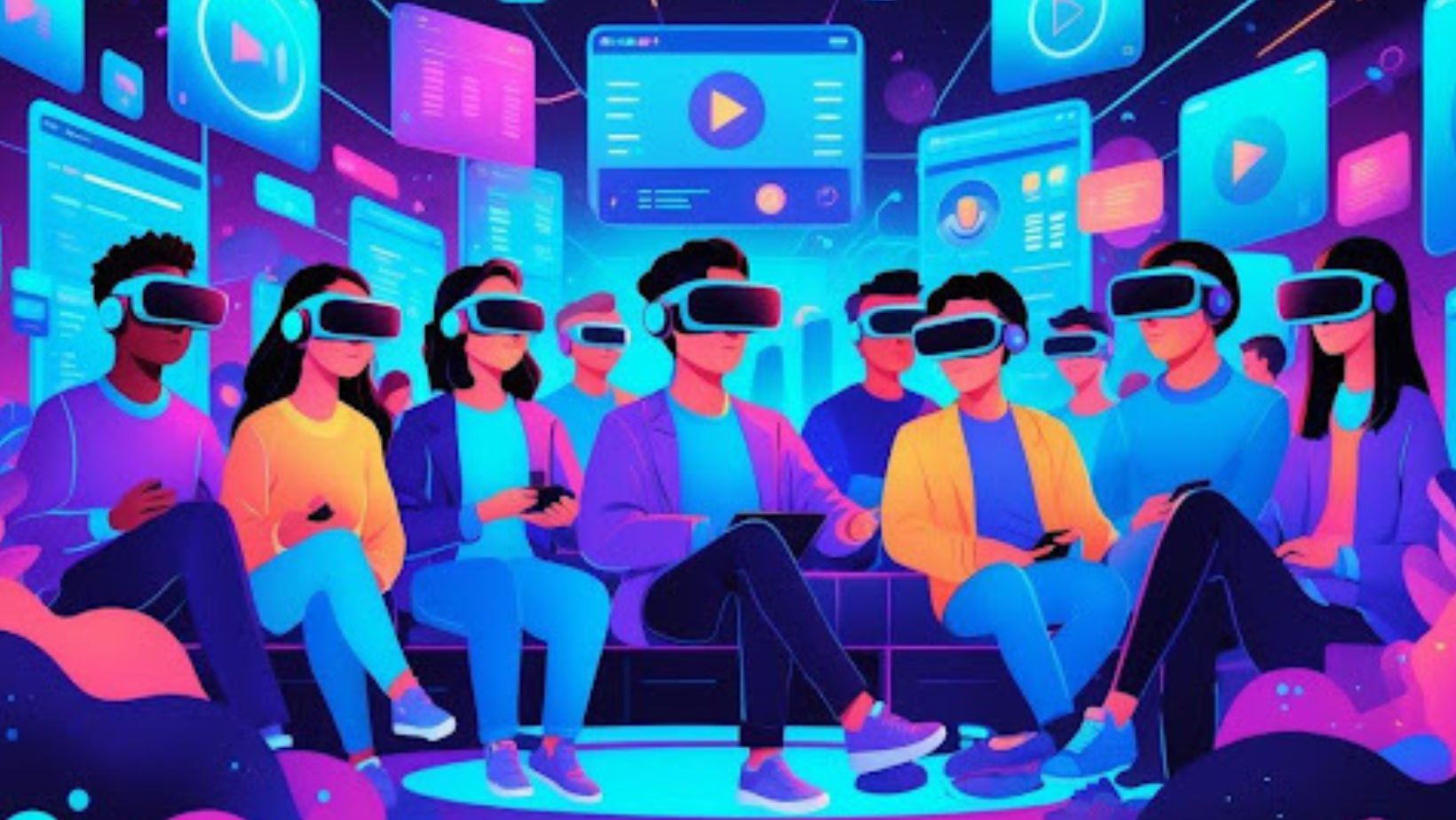Table of Contents
ToggleThe Evolution of Digital Entertainment Through VR and Live Streaming
Not that long ago, digital entertainment was a pretty passive affair. But with the rise of VR and live streaming, audiences don’t just watch, they get to shape and participate in the experience.
Virtual reality and streaming platforms have pushed digital entertainment from simple, linear viewing to something way more interactive and unpredictable. It’s no longer about just sitting back; people want to jump in, connect, and even steer what’s happening in real time.
From Traditional Gaming to Immersive Experiences
Remember when gaming meant staring at a flat screen and fiddling with a controller? That’s changed dramatically thanks to immersive VR technology.
These days, VR lets you step right into a 360-degree world. Haptic feedback and motion tracking make every movement feel more lifelike, almost like you’re actually there.
Game genres have exploded. Puzzle and adventure titles now let you physically manipulate objects, while racing games offer cockpit views that put you in the driver’s seat. The difference is honestly night and day compared to old-school setups.
It’s fascinating how new tech is redefining what it means to play, not just making things prettier but actually transforming how people interact with digital worlds. If you’re curious, check out this guide to immersive experiences.
Rise of Streaming Platforms in Entertainment
Streaming has flipped the script on how we watch movies, shows, and even games. Instead of waiting for downloads or dealing with physical media, everything’s just a click away through platforms like Netflix, Twitch, and YouTube.
For fans of live events or esports, streaming means you can tune in from anywhere. Creators now reach global audiences instantly, sidestepping the old gatekeepers.
But it’s not just about access. Platforms have built-in chat, polls, and live reactions, turning passive viewing into a group activity. It’s wild how much more social watching something can feel now.
There’s no denying that streaming has become a cornerstone for both gaming and mainstream media. The constant availability and real-time participation are a big part of why.
Convergence of Gaming and Streaming Technologies
Gaming and streaming have started to blend together in ways that would’ve sounded sci-fi a few years ago. Gamers aren’t just playing, they’re broadcasting, creating content as they go.
With VR, streamers can share what they see from inside the headset, giving viewers a first-person look. It’s a way more engaging broadcast than watching someone’s screen.
Some platforms are testing interactive streams where the audience can actually influence the game in real time. It’s a collaborative vibe, blurring the gap between player and viewer.
As internet speeds and hardware get better, expect this mix of VR and live streaming to keep evolving. The potential for richer, more interactive entertainment is huge. For more, see this article on emerging tech.
Virtual Reality’s Expanding Role in Entertainment
VR is quickly becoming a major player in digital entertainment. The latest headsets and software are making it easier than ever to dive in, move naturally, and access a ton of new experiences.
It’s not just about games anymore. People are using VR for concerts, social hangouts, and even art galleries. The sense of presence is pretty hard to describe until you try it yourself.
VR Gaming and Multiplayer Experiences
Multiplayer VR is where things get really interesting. Platforms like VRChat and Rec Room let people hang out, play, and even build worlds together in 3D spaces.
Developers are designing games that require teamwork, think escape rooms or tactical shooters, where communication is just as important as skill. It’s a level of connection you don’t get from regular games.
Cross-play is also a big deal now. PC and standalone headset users can join the same games, making communities bigger and more active. As internet infrastructure improves, expect these worlds to get even more expansive.
Motion Tracking and Immersion in VR and Live Streaming
Motion tracking is what makes VR (and by extension, some live streaming) feel real. Headsets track where you look and move, while controllers let you interact with digital objects almost like they’re physical.
High-end setups like HTC Vive use external sensors for super accurate movement. But even standalone headsets like Meta’s Quest series offer solid tracking without a tangle of wires.
Some users go all out with full-body tracking. Avatars can mirror your dance moves or gestures, making social VR platforms feel alive. The better the tracking, the less likely you are to get motion sick, which is a big plus for longer sessions.
Popular VR Headsets and Platforms
The Oculus Quest 2 and Quest 3 are everywhere these days. They’re wireless, don’t need a PC, and still let you connect for more complex games when you want.
HTC Vive and Valve Index are still top picks for enthusiasts who want the best visuals and tracking, though they do require a bit more setup. Choice really depends on what you’re after, casual socializing or high-end gaming.
Platforms like Meta’s Horizon Worlds, VRChat, and SteamVR each offer something different, from easy social spaces to deep customization and modding. Together, they’re shaping how we experience VR entertainment right now.
Live Streaming: Redefining Audience Engagement
Live streaming isn’t just about sharing gameplay or chatting anymore. It’s turned into a way for audiences to jump in, shape what’s happening, and build real communities, often in tandem with VR experiences and cloud gaming.
With technologies evolving, streaming is now about direct participation. It’s not uncommon to see viewers influencing a stream or even joining in on the action.
Interactive Live Events and Virtual Concerts with VR and Live Streaming
Virtual concerts have exploded, especially with live streaming tech. Artists perform in digital venues, and fans can join from anywhere, no travel, no lines.
Some streams let viewers pick camera angles or send reactions that appear in real time. You can even vote on the next song or trigger special effects. It’s a level of interaction that’s hard to match with in-person events.
For artists, this means reaching global audiences and experimenting with new revenue streams like digital merch or exclusive fan meetups. Organizers also save a ton on logistics.
It’s not perfect, but the flexibility and reach are undeniable.
Community Building Through Real-Time Streaming
One of the best things about live streaming is the way it builds community. Viewers aren’t just watching, they’re chatting, voting, and reacting together in real time.
This is especially true for gaming streams, where audiences often suggest strategies or even steer the action. But it works for educational and creative streams too.
Communities don’t disappear when the stream ends. Fan groups, replay sharing, and ongoing chats keep people connected. That kind of loyalty is hard to build anywhere else.
Creators get instant feedback and can change up their content on the fly. It’s a more personal, dynamic way to connect with an audience.
Integration of Cloud Gaming in VR and Live Streaming
Cloud gaming is making a big impact on streaming. Instead of needing a fancy gaming PC, players stream games from remote servers to almost any device, even phones or tablets.
Some streaming platforms now let viewers jump straight from watching a game to playing it themselves. No downloads, no waiting. It’s a seamless transition that lowers the barrier for everyone.
Interactive formats are popping up too. Audiences can join multiplayer sessions directly from a live stream, blurring the line between viewer and participant.
Lower hardware costs and instant access are a big win. When combined with live streaming, it’s opening up digital entertainment to way more people.
The Metaverse and Virtual Worlds Beyond Gaming
The metaverse is shaking up digital entertainment by creating shared spaces, new ways to earn and spend, and smarter, more personalized experiences. It’s not just about games anymore, it’s about how we connect and create together.
People are forming communities, attending events, and even building businesses in these virtual spaces. The possibilities feel almost endless, though there’s still plenty to figure out.
Immersive Social Spaces and Virtual Adventures with VR and Live Streaming
Virtual worlds are now social playgrounds where people meet, chat, and explore. Unlike a basic video call, these environments use avatars, voice, and gesture tracking to make things feel surprisingly real.
Entertainment goes beyond watching, a concert or festival in a virtual space lets you move around, interact, and even change the outcome. Persistent worlds keep evolving, so there’s always something new to come back to.
These experiences blend gaming with live events, offering a kind of flexibility and immersion that’s hard to replicate elsewhere.
Blockchain and NFTs in Digital Entertainment
Blockchain tech is starting to shape how we own and trade digital stuff in virtual worlds. NFTs let users prove they own unique items, anything from virtual land to digital music.
Some companies are using NFTs as tickets for virtual events or as collectibles tied to streaming milestones. It’s a new way for fans to support creators and get exclusive perks.
Still, there are concerns about the sustainability and value of these assets. The space is evolving fast, and it’ll be interesting to see which uses stick around.
Personalization and AI-Driven Experiences
AI is making the metaverse and digital entertainment more personal than ever. Algorithms recommend events, suggest communities, or even tweak environments to fit your tastes.
Moderation and accessibility are getting better too. Automated tools help keep things safe, while adaptive systems make spaces easier for everyone to use.
In virtual adventures, AI-controlled characters can react in real time, making stories feel less scripted and more alive. It’s a subtle shift, but it really boosts engagement and replay value.
Augmented and Mixed Reality in Entertainment
Augmented Reality, Mixed Reality, and the evolution of VR and Live Streaming are shaking up digital entertainment in ways we couldn’t have imagined a decade ago. These technologies aren’t just about watching anymore, they’re about stepping inside the action, blending the virtual with our everyday world.
It’s not just passive viewing. Audiences now get to play a role, sometimes literally, thanks to participation-driven experiences that merge narrative media with live performance.
VR and Live Streaming in Interactive Storytelling
With AR and MR, the line between viewer and participant blurs. Instead of just watching, people can interact with characters and environments that pop up right in their own living rooms.
Imagine unlocking secret plot twists through your phone or headset. MR applications can take it further, letting you wander through 3D scenes that feel like they’re part of your actual space.
- Branching narratives, your choices can change the story’s ending.
- Spatial interaction with digital props and settings.
- Personalized content that actually responds to what you do.
Suddenly, entertainment feels personal. You’re not just watching a story; you’re shaping it, nudging it forward, and making it your own.
VR and Live Streaming for Live Performances and Theater
Theater and concerts are embracing AR, MR, and live streaming to pull audiences deeper into the show. Digital characters can appear beside real performers, and effects can overlay the stage through headsets or even smartphones.
In interactive theater, the audience isn’t just sitting back. They might follow a digital clue around the venue, chat with projected characters, or unlock hidden storylines tied to their spot in the space.
Some productions use mixed reality to create shared illusions, everyone, from actors to viewers, sees the same digital magic unfold live. It’s a clever way to deliver big visuals without hauling around massive props.
By mixing physical presence with digital overlays, AR and MR boost immersion but keep that special energy you only get from live, in-person events.
VR and Live Streaming: Emerging Tech in Digital Entertainment
Digital entertainment’s future is being shaped by VR and Live Streaming, alongside other cutting-edge tools. These advances make media more immersive and surprisingly personal.
Virtual reality hardware keeps getting better. Headsets are lighter, more comfortable, and the visuals? Way sharper than before. Higher field of view and faster refresh rates are reducing motion sickness, making it easier to lose yourself in a game or movie for hours.
Wireless headsets are a game changer, letting you move freely without tripping over cables. That practicality is opening the door for more people to try VR at home. (And let’s be honest, nobody misses the tangle of wires.)
VR and Live Streaming: Hardware, Software, and Cloud
Software isn’t lagging behind. Developers are baking in haptic feedback and spatial audio, creating a sense of presence that’s hard to describe until you try it. Social VR platforms are letting people meet up in virtual spaces, blurring the lines between entertainment and hanging out.
Cloud streaming is making a real difference, too. Professional broadcasters often rely on a dedicated server for streaming to ensure consistent bitrates, minimal latency, and the capacity to handle thousands of concurrent viewers without performance degradation. Now, you don’t need a monster PC, VR content can run on remote servers and stream straight to your headset. That means lower costs and more people able to jump in.
| Key Improvements | Impact on Users |
|---|---|
| Higher resolution displays | Clearer visuals |
| Wireless headsets | Easier movement |
| Haptic feedback | More immersion |
| Cloud VR streaming | Lower hardware costs |
According to a 2023 Statista report, the global VR and AR market is expected to exceed $250 billion by 2028, with live streaming and immersive content driving much of the growth. In fact, over 65% of Gen Z consumers say they’re interested in interactive or participatory digital experiences, especially those blending VR and live streaming elements.
Honestly, it feels like we’re only scratching the surface. With each leap in hardware and software, those old boundaries between viewer and participant keep fading. Who knows, maybe next year, we’ll be talking about something even wilder.
Role of AI in Personalization and Content Creation for VR and Live Streaming
AI’s got a huge hand in shaping how people discover what to watch, especially with VR and live streaming platforms. Recommendation algorithms quietly sift through your viewing habits, nudging you toward shows, games, or streams that just click with your taste.
It’s honestly impressive, less time scrolling, more time actually enjoying content. According to a 2023 Statista report, over 78% of streaming viewers say tailored suggestions keep them on a platform longer (source).
For creators, AI’s become a versatile toolkit. Think digital avatars that move almost like real people, auto-generated subtitles, or even smart script-writing assistants that help punch up dialogue. All this means smaller teams can churn out work that looks and feels professional.
What’s wild is how personalization’s evolved. Some VR and live streaming services now tweak storylines or gameplay on the fly based on your decisions, thanks to AI. Suddenly, you’re not just watching, you’re part of something unique, every single time.
Moderation’s a big deal in live broadcasts. AI-powered systems keep tabs on chat, zapping harmful messages before most people even notice. It’s not perfect, but it goes a long way toward making these spaces safer for everyone involved.





